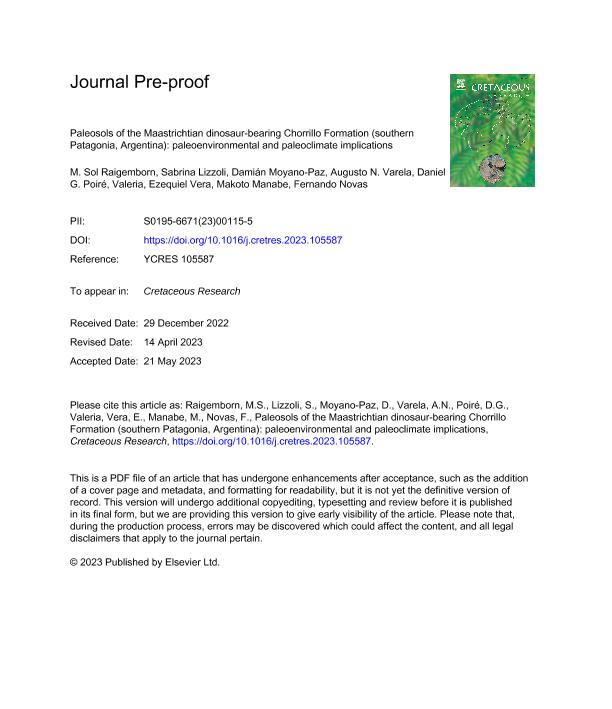Artículo
Paleosols of the Maastrichtian dinosaur-bearing Chorrillo Formation (southern Patagonia, Argentina): Paleoenvironmental and paleoclimate implications
Raigemborn, María Sol ; Lizzoli, Sabrina
; Lizzoli, Sabrina ; Moyano Paz, Damián
; Moyano Paz, Damián ; Varela, Augusto Nicolas
; Varela, Augusto Nicolas ; Poire, Daniel Gustavo
; Poire, Daniel Gustavo ; Perez Loinaze, Valeria Susana
; Perez Loinaze, Valeria Susana ; Vera, Ezequiel Ignacio
; Vera, Ezequiel Ignacio ; Manabe, Makoto; Novas, Fernando Emilio
; Manabe, Makoto; Novas, Fernando Emilio
 ; Lizzoli, Sabrina
; Lizzoli, Sabrina ; Moyano Paz, Damián
; Moyano Paz, Damián ; Varela, Augusto Nicolas
; Varela, Augusto Nicolas ; Poire, Daniel Gustavo
; Poire, Daniel Gustavo ; Perez Loinaze, Valeria Susana
; Perez Loinaze, Valeria Susana ; Vera, Ezequiel Ignacio
; Vera, Ezequiel Ignacio ; Manabe, Makoto; Novas, Fernando Emilio
; Manabe, Makoto; Novas, Fernando Emilio
Fecha de publicación:
10/2023
Editorial:
Academic Press Ltd - Elsevier Science Ltd
Revista:
Cretaceous Research
ISSN:
0195-6671
Idioma:
Inglés
Tipo de recurso:
Artículo publicado
Clasificación temática:
Resumen
The Maastrichtian dinosaur-bearing Chorrillo Formation in southern Patagonia (⁓50° S, Austral-Magallanes Basin, Argentina) is a pedogenically modified fluvial succession, which records sediment deposition at mid–high paleolatitudes in the Southern Hemisphere. In order to reconstruct the paleoenvironment and paleoclimates for the Chorrillo Formation, we performed a paleopedological study (abiotic components) of the unit within a well-defined sedimentological–paleontological context, and considering new paleobotanical data of the unit. Using detailed macro and micromorphological features and clay mineralogy of the paleosols, we show that the Chorrillo Formation paleosols are overall smectite-rich soils with vertic and redoximorphic features (i.e., moderately developed hydromorphic Vertisol-, calcic Vertisol-, poorly developed hydromorphic Vertisol-, Histosol-, and argillic Vertisol-like paleosols). The small-scale or high-frequency stacking of such paleosols indicates that they developed under different hydrologic conditions, and subtle differences in grain-size (parent material) and topographic relief on a distal floodplain. Conversely, the large-scale or small-frequency vertical stacking of different paleosols is linked to avulsion processes. Paleobotanical remains through the Chorrillo succession demonstrates different ecological requirements for the inhabited part of the fluvial floodplain. Abiotic and biotic climate proxies suggest that these paleosols formed under a broadly temperate–warm and seasonally humid climate. Overall, these combined data record environmental and climatic conditions during the uppermost Cretaceous, and preserve a record of Maastrichtian terrestrial conditions in the Southern Hemisphere.
Palabras clave:
CLAY-MINERALOGY
,
CRETACEOUS
,
HYDROMORPHISM
,
MICROMORPHOLOGY
,
PALYNOLOGY
,
VERTISOLS
Archivos asociados
Licencia
Identificadores
Colecciones
Articulos(CIG)
Articulos de CENTRO DE INVEST.GEOLOGICAS (I)
Articulos de CENTRO DE INVEST.GEOLOGICAS (I)
Articulos(MACNBR)
Articulos de MUSEO ARG.DE CS.NAT "BERNARDINO RIVADAVIA"
Articulos de MUSEO ARG.DE CS.NAT "BERNARDINO RIVADAVIA"
Citación
Raigemborn, María Sol; Lizzoli, Sabrina; Moyano Paz, Damián; Varela, Augusto Nicolas; Poire, Daniel Gustavo; et al.; Paleosols of the Maastrichtian dinosaur-bearing Chorrillo Formation (southern Patagonia, Argentina): Paleoenvironmental and paleoclimate implications; Academic Press Ltd - Elsevier Science Ltd; Cretaceous Research; 150; 10-2023; 1-24
Compartir
Altmétricas



